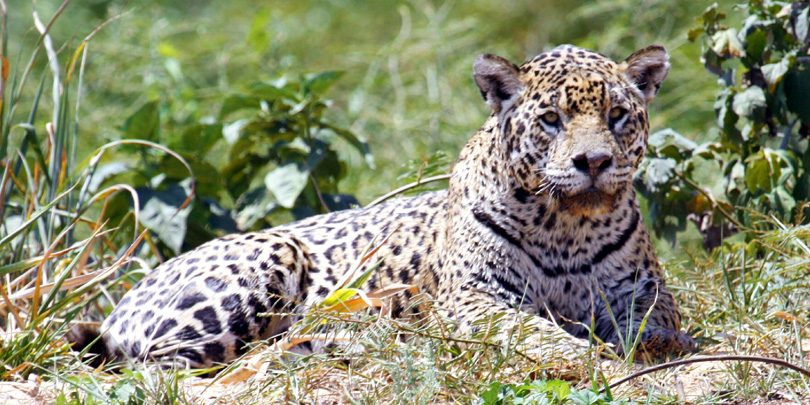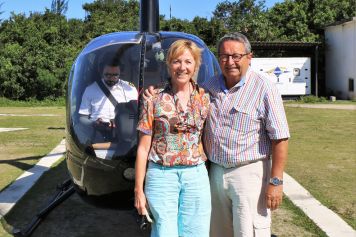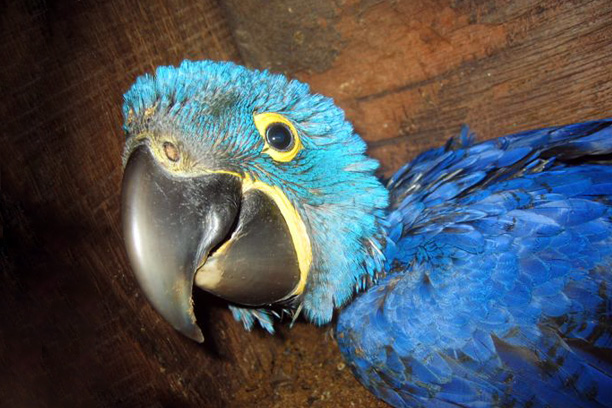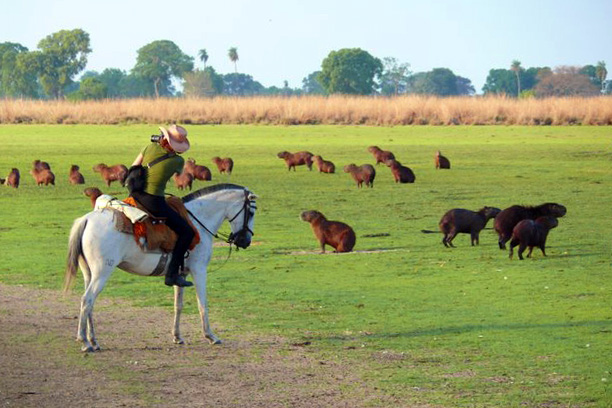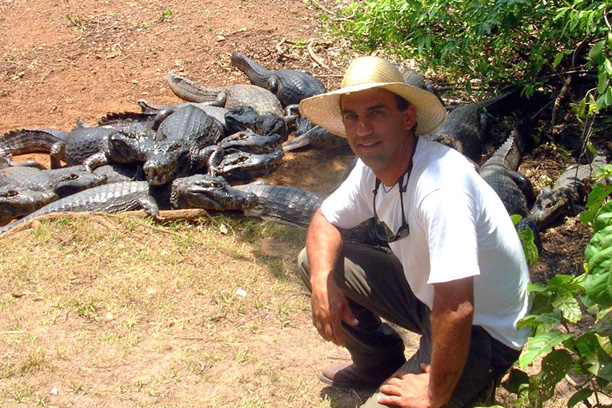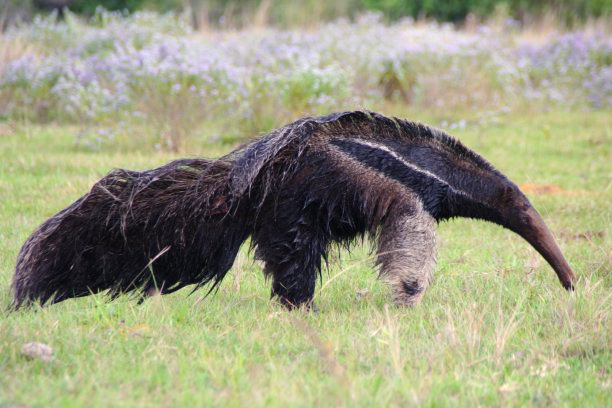Description
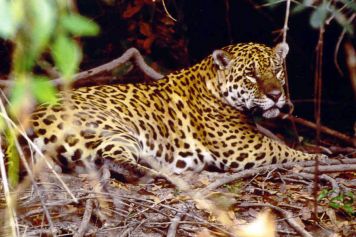 The Jaguar (Panthera onca) is noted for having the most powerful jaws of all wildcats, although not reaching the size of lions or tigers. Nevertheless the average weight of adult males is 227 lb, however, jaguars weighting more than 320 lb have reportedly been caught in the Pantanal. Because of the exuberant food supply offered by the rich wildlife in the Pantanal, his size outreaches almost twice the Central-American jaguars. The jaguar or onça pintada, how he is called in Portuguese, lives solitary and prefers habitats close to water, especially gallery forest. It stands under strict protection and sustains the status of CITES Appendix I of the Washington endangered species convention.
The Jaguar (Panthera onca) is noted for having the most powerful jaws of all wildcats, although not reaching the size of lions or tigers. Nevertheless the average weight of adult males is 227 lb, however, jaguars weighting more than 320 lb have reportedly been caught in the Pantanal. Because of the exuberant food supply offered by the rich wildlife in the Pantanal, his size outreaches almost twice the Central-American jaguars. The jaguar or onça pintada, how he is called in Portuguese, lives solitary and prefers habitats close to water, especially gallery forest. It stands under strict protection and sustains the status of CITES Appendix I of the Washington endangered species convention.
Contrary to many travel organizations publicity, the jaguar can be observed best not in the impenetrable Amazonian rainforest but in the bush lands and savannahs of the Pantanal. Being nocturnal the Jaguar is supposed to be generally evasive during the day. However, since there are no natural enemies to him, except humans and they obey to a rather protective policy nowadays, the big feline feels at ease even during the day. Due to the extreme mobility during his nightly hunts the Jaguar covers a huge area in a short period of time. The observation of this predator during the day requires therefore time and patience. It can mostly be observed relaxing on riverbanks, fishing and crossing rivers or even in the vicinity of human settlements.
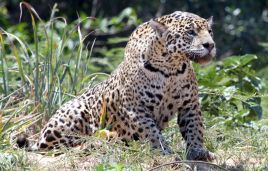 | 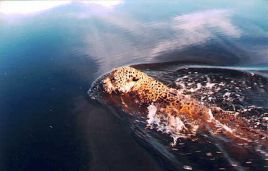 | 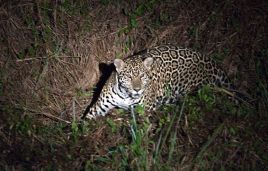 |
Guest Comments
Guest Comments
Max and Irene
Zurich, Switzerland
The 25 days Amazonia and Pantanal were one of the most impressive trips that we as experienced safari fans have ever experienced. The preliminary talks with you and our clearly defined wishes were very pleasant and creative right from the start, the result culminated in this adventure. Just the dimensions of Amazonia exceed our imagination, and then suddenly to find yourself in a side arm of the Rio Negro, far away from any civilization, pure nature, the voices of the birds, howler monkeys, the blowing of the pink dolphins, simply indescribable!
The crew of the IARA was kind of helpful and always focused on bringing us closer to the beauties of this still pristine nature during day and night stalking. Sloth, anaconda, various species of monkeys, caimans, fishing for piranhas yourself and then enjoying it, that's what we call pure adventure. The kitchen of Si, the cook, was very tasty and varied. Saying goodbye to the lovely people was difficult, but the highlight of our trip was still ahead of us, the sighting of the last big cat we were missing - the jaguar. Already on the first stalk from Porto Jofre, we discovered not one, no, three of the beautiful cats, a female with her two teenagers. Unbelievable, and that at distances of 5-10 meters from a safe boat. More sightings were to follow, we were able to observe a total of 9 different jaguars. But there are also countless cute giant otters, capybaras, caimans and two other anacondas. Endless birds in the idyllic narrow gullies, which always offered something new.
Then the fantastic private flight with the Cessna 206 from Campo Grande from 1h 20 over the wide Pantanal and then the landing directly in front of the Hacienda Pousada das Pedras where we were warmly welcomed by Rita, the lovable and experienced hostess. The newly built, spacious suite rooms and top bathrooms were very appealing, and the kitchen was also extremely tasty, including caipirinhas and wines. Great! Here we should discover the last "missing" animals with our guide and Rita. We were able to sneak up on 2 tapirs and 3 anteaters in Indian style against the wind and take great photos. But also armadillo, pantan fox and swamp deer paid their respects. We could watch hyacinth macaws and toucans right in front of the room from the hammock.
Then it was time to travel back to the civilization of Rio de Janeiro, where we were allowed to enjoy another 4 wonderful days, until we had 2000 photos and 90 videos in our luggage.We said:
Adeus Brazil, foi muito lindo!
Southern Cross and by that, we mean mainly Peter the owner, definitely delivered and never promised too much. The four guides who looked after and guided us all this time were top class. Both as people and as extremely experienced specialists in their field. We were able to learn a lot and take it with us from this fantastic, most biodiverse country on earth, many thanks for everything Peter.
Max und Irene
Helga and Manfred Leubner, Norbert Braunitsch
Offenberg and Munich, Germany
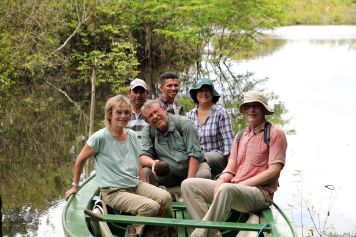
Our next destination was the northern Pantanal. We want to go on a Jaguar Safari! The drive on the Transpantaneira, an earth road with 125 wooden bridges, was like traveling through an animal or bird park. Masses of caimans cavort here at water holes, capybaras, anaconda and flocks of large water birds. We stayed overnight at a typical Ranch where we went on safari next morning before continued our journey to Porto Jofre, at the end of the Transpantaneira road.
Porto Jofre is the ideally located to watch Jaguars on the São Lorenço. Piqueri and Cuiaba rivers.
We went on the jaguar stalk by boat. It had an outboard engine and light aluminum casing for fast moving when it was necessary. During the 6 days of our stay in the region, we were able to observe several jaguars every day. We saw him prowling along the bank, hunting and fighting with a competitor. We could also watch him mating. Once he swam next to the boat. Another time he suddenly jumped into the water in front of our boat. Fortunately, he was not aiming at us, but at a caiman, which for once got away from him.
We also observed cute capybaras (the largest species of rodent) and the giant otters. On walking safaris and game drives we were able to watch anteaters, coatis, tapirs regularly and the jaguar came across our way twice.
Now we wanted to get to know the savannah landscape of the southern Pantanal. As Peter Rohmer assured us, it should be particularly easy in the relatively open area there to observe and photograph the diverse fauna of Brazil.
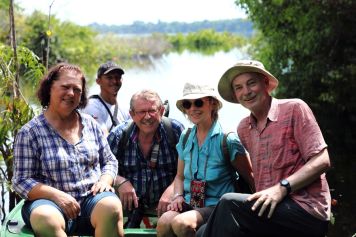 With a small, twin-engine private plane, we flew to another highlight of our trip to Brazils natural wonders. This flight over the Pantanal at low altitudes is a great experience in itself. We visited an 18,000 hectare fazenda in the Nhecolânida region.The charming, typical landscape of the southern Pantanal awaited us. Meadows, ponds, swamps, woods alternate, pure landscape. There are no streets, buildings, power lines! Nothing, just nature! We went on Photo Safari twice a day with the 4x4 Land Rover. In addition to the many mammals and reptiles, particularly were we impressed by the incredible biodiversity of the birds. There are around 600 species. Herons, ibises, railings, pink spoonbills, ducks, geese, storks, birds of prey, owls, parrots, amazons, toucans and all three great macaw species, i.e. the yellow and blue, red-winged and hyacinth macaws, were super easy to observe and photograph. A paradise not only for bird lovers who get their money's worth here.
With a small, twin-engine private plane, we flew to another highlight of our trip to Brazils natural wonders. This flight over the Pantanal at low altitudes is a great experience in itself. We visited an 18,000 hectare fazenda in the Nhecolânida region.The charming, typical landscape of the southern Pantanal awaited us. Meadows, ponds, swamps, woods alternate, pure landscape. There are no streets, buildings, power lines! Nothing, just nature! We went on Photo Safari twice a day with the 4x4 Land Rover. In addition to the many mammals and reptiles, particularly were we impressed by the incredible biodiversity of the birds. There are around 600 species. Herons, ibises, railings, pink spoonbills, ducks, geese, storks, birds of prey, owls, parrots, amazons, toucans and all three great macaw species, i.e. the yellow and blue, red-winged and hyacinth macaws, were super easy to observe and photograph. A paradise not only for bird lovers who get their money's worth here.
In addition, we were able to monitor the work of 2 NGO´s working on two species protection projects, namely for the giant armadillo Priodontes maximus and the tapir Tapirus terrestris. That was extremely interesting for us.
If you want to experience the cowboys of South America, you have to come here! They take care of the approximately 12,000 cattle and 240 horses of the fazenda. We rode with them to the herds and watched them at work. The cowboys skilfully roped cattle in full gallop. Invited to join in driving the herd reminded us of our teenage days when we dreamed of riding with the cowboys of the Wild West.
In conclusion, we can say that this very special journey, justifiably offered as “The Journey of Your Life”, will occupy our minds for a long time to come.
The entire organization of the trip was perfect! The boat with two cabins on the Rio Negro in the Amazon, the vehicles (cars, small aircraft) as well as the driver and guide surpassed our expectations.
Next year or the year after we want more of the same. I will get in touch with you in due time.
Our sincere thanks go to Peter Rohmer from Southern Cross Tours & Expeditions and his strong team, whose perfect planning made our individual trip so successful and which gave us a lot of pleasure.
Greetings from Manfred, Helga and Norbert
William Fleming "Safari Bill"
Wildlife Photographer
Hi Peter,
I arrived home safe and sound. Thank you very much for arranging an excellent photo safari. I enjoyed your company and felt that you always had my interests in mind.
I guess people are always looking for a bargain instead of what opportunities offer them the best chance for sucess in a photo safari. That is money foolishly spent.
I am very pleased that none of the wildlife photographers I admire most have a wild jaguar photo. They only have shots from the Belize Zoo. That shot is worth all the time and money I have spent over the years.
Warm regards and thank you,
Safari Bill
Prices & Travel Details
Prices and Travel Details
| Travel Time | 6-8 days |
|---|---|
| Group Size | maximum 4 participants |
| Travel Dates | please ask for actual travel dates |
| detailed itinerary upon request | |
| Prices | on request |
Please note that qualified wildlife guides and accomodations are limited. We therefore highly recommend to make sure that bookings are being placed at least 6 or even 8 month prior travel date.

